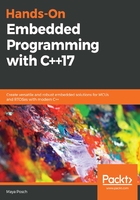
上QQ阅读APP看书,第一时间看更新
Hardware
The block diagram of the clubstatus system looks as follows:

For the SBC platform, we use a Raspberry Pi, either the Raspberry Pi B+ model or a newer member of the B-series, such as the Raspberry Pi 3 Model B:

The main features we are looking for in the SBC system are an Ethernet connection and, of course, the Raspberry Pi-compatible general-purpose input/output (GPIO) header.
With this board, we'll use a standard Raspbian OS installation on the μSD card. No special configuration is needed beyond this. The primary reason for choosing the B+ model or similar is that these have a standard mounting hole pattern.